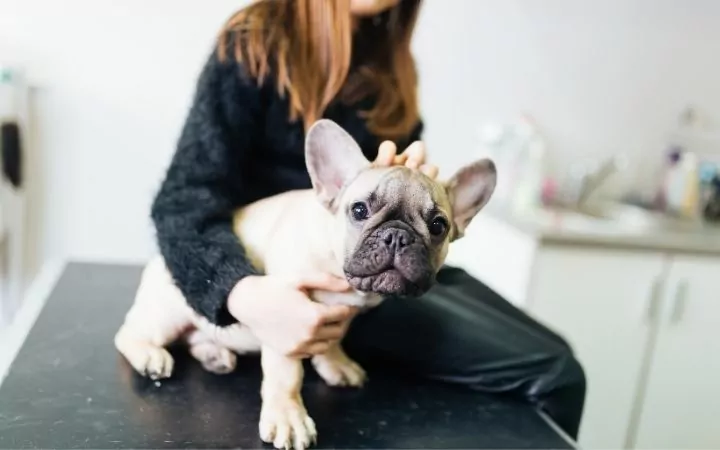Chocolate. As pet owners, we love it but dread having it in the house. For many pet owners, it is a well-known fact that dogs simply cannot have chocolate. But did you ever stop and think of why chocolate is bad for dogs? Read below!
Why Dogs and Chocolate are a Toxic Combination
Can your dog eat chocolate? The assured answer here is no. That being said, you are probably curious why they cannot indulge.

So chocolate contains two substances that are toxic to our dogs. One we know of as caffeine (very well as veterinary professionals), and the other is theobromine. The main culprit affecting our dogs is theobromine. However, the combination is what makes chocolate so toxic.
Our dogs cannot handle caffeine and theobromine as well as their human owners. This is what makes them so sensitive to it and thus resulting in unwanted clinical signs. Both of these chemicals act as a diuretic (increased production of urine), heart stimulant, muscle relaxant, and blood vessel dilator.
Clinical Signs and Symptoms of Chocolate Toxicity
So your dog has ingested chocolate, and you’re not sure what to expect. Below is a list of clinical signs commonly seen in chocolate toxicity cases.
- Vomiting
- Diarrhea
- Polydipsia (increased thirst)
- Polyuria (increased urination)
- Panting
- Tachycardia (increased heart rate)
- Hyperthermia (increased body temperature)
In severe cases:
- Muscle tremors
- Seizures
- Heart failure
- Collapse
Toxic Foods High in Theobromine

Of course, we’re mostly aware of what foods contain chocolate but let’s discuss which foods contain the most theobromine. There’s a direct correlation between how dark the chocolate is to how dangerous it is.
For example, Bakers chocolate contains ~450 mg/oz of theobromine, whereas milk chocolate contains ~64 mg/oz (2.3 mg/g), and white chocolate barely contains any.
Below is a list of typical household treats, their theobromine, and caffeine levels. Remember, ingredients vary depending on the brand and source of cocoa.
- Cookies and brownies:
Serving Size- 1 square
Theobromine- 43.7mg
Caffeine- 1.1mg - Hershey’s chocolate syrup:
Serving Size- 2 tbsp
Theobromine- 64mg
Caffeine- 9mg - Hershey’s Semi-Sweet Baking Bar:
Serving Size- 1 Tbsp
Theobromine: 55mg
Caffeine- 7mg - Ready to Eat Chocolate Pudding:
Serving Size- 4 oz
Theobromine: 75.6mg
Caffeine: 2.2mg - Hershey’s KISSES (Milk Chocolate):
Serving Size: 9 pieces
Theobromine: 61mg
Caffeine: 9mg
- Oreos
Serving Size-3 cookies
Theobromine-2.4mg
Caffeine-0.85mg
- Semi-sweet Chocolate Chips
Serving Size-1 ounce
Theobromine-150mg
Caffeine - Hot chocolate mix
Serving Size- 1 ounce
Theobromine-130mg
Caffeine-15-20mg
Chocolate Toxicity and the Canine Heart

So we know what’s in chocolate that makes it unfriendly to our canine friends. Let’s now discuss in depth why it’s toxic. The main organ that is affected by chocolate is the heart.
First, your dog ingests the chocolate, which is absorbed by your dogs’ gastrointestinal tract and spread throughout the dog’s body. After a few short hours, your dog will start to show signs of chocolate toxicosis.
If your dog already has heart disease, then the prognosis is much worse vs. a dog that does not. This is because theobromine and caffeine will stimulate the nervous system and also speed up the heart rate.
The heart rate being sped up will cause your dog to pant and seem restless. The chocolate being absorbed by your dog’s gastrointestinal tract may cause him/her to vomit or have diarrhea.
The Canine Chocolate Toxicity Calculator
So, just how toxic is chocolate for dogs? Well, that depends entirely on your dog’s weight, how much they ate, and which type of chocolate. As stated before the darker chocolate is more toxic than milk chocolate, and the smaller the dog, the more likely they are to be affected.
Since this toxicity has been well researched and studied, there is an LD50 (lethal dose for 50% of the animal in the dose group), which is 100–200 mg/kg. This is how the toxicity calculator comes up with its numbers.
The calculator is found on numerous websites, which will help you and owners alike determine if your dog is at a dangerous level of toxicity and when to seek immediate treatment. Of course, it is always better to contact your veterinarian for the next step than to take matters into your own hands.
One such website is vets now.
My Dog Ate Chocolate, What Now?
So your dog dove deep into the Halloween candy that was left on the floor, and all you see are wrappers everywhere. Oh, and your dog is covered in brown sweet-smelling goo that you identified as chocolate, making it evident that your dog ate the chocolate.

What should you do next? First, call your veterinarian, of course, and seek immediate advice. They will tell you your next step and ask you to hopefully bring your dog in immediately to seek care.
Another option if your veterinarian cannot be reached is calling your pet poison control of choice. Remember, the quicker you act, the better. The longer you wait for the onset of clinical signs, the worse the prognosis.
It is always important to seek veterinarian care because early intervention can be the difference between a small handable problem and a large one. If this isn’t possible, keep a close eye on your dog and research the best emergency clinics in your area.
How are Dogs Treated That Ingested Chocolate?
Dogs who have ingested chocolate should be seen by a veterinarian immediately. If your dog had just eaten, the chocolate-induced vomiting (via medications) might be performed along with the administration of activated charcoal.
Activated charcoal is a liquid substance that allows for drugs and other substances to bind to it when ingested. The chemicals are unable to be absorbed into your dog’s body resulting in more minor issues.
The two above treatments often follow supportive care and observation. Supportive care includes intravenous fluids via an intravenous catheter, medications to slow down the heart rate, and observation for any signs of the condition worsening.

Tremors can be treated via anti-seizure medication, and any potential arrhythmias should be treated as needed. Electrocardiograms should be performed to keep a close eye on your dog’s heart status, as well as baseline bloodwork to determine if any abnormalities need to be corrected. If hyperthermia occurs, then slowly bringing down your dog’s temperature should also be in the works.
It would be likely and wise for your dog to do an overnight stay in a clinic that has 24-hour care. This ensures that a veterinary professional is observing your dog, and therefore they can act if any problem should arise or worsen.
Summary
The safest way to avoid your dog eating chocolate is not to have it. But, for some of us with a super sweet tooth, we cannot prevent it. If this is the case, it is best to keep it in a high locked cabinet out of reach to your pets or children.
If your dog does get into chocolate, it is best to act fast and be proactive about it. The longer you wait, the longer it has a chance to be absorbed by your dog’s body and start creating a bed of issues. Luckily there is a lot of information out there, and most veterinarians know how to treat it.
